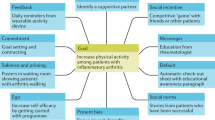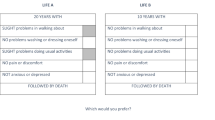Abstract
Changing physical activity and dietary behavior in chronic disease patients is associated with significant health benefits but is difficult to achieve. An often-used strategy is for the physician or other health professional to encourage behavior changes by providing advice on the health consequences of such behaviors. However, adherence to advice on health behavior change varies across individuals. This paper uses data from a population-based cross-sectional survey of 1849 individuals with chronic disease to explore whether differences in individuals’ time and risk preferences can help explain differences in adherence. Health behaviors are viewed as investments in health capital within the Grossman model. Physician advice plays a role in the model in that it improves the understanding of the future health consequences of investments. It can be hypothesized that the effect of advice on health behavior will depend on an individuals’ time and risk preference. Within the survey, which measured a variety of health-related behaviors and outcomes, including receipt and compliance with advice on dietary and physical activity changes, time preferences were measured using financial planning horizon, and risk preferences were measured through a commonly used question which asked respondents to indicate their willingness to take risks on a ten-point scale. Results suggest that time preferences play a role in adherence to physical activity advice. While time preferences also play a role in adherence to dietary advice, this effect is only apparent for males. Risk preferences do not seem to be associated with adherence. The results suggest that increasing the salience of more immediate benefits of health behavior change may improve adherence.

Similar content being viewed by others
Notes
In the remainder of the paper, the term physician advice includes advice from physician or any other health professional.
References
Adams, J., Nettle, D.: Time perspective, personality and smoking, body mass, and physical activity: an empirical study. Br. J. Health Psychol. 14, 83–105 (2009)
Becker, G.S., Mulligan, C.B.: The endogenous determination of time preference. Q. J. Econ. 112, 729–758 (1997)
Barsky, R.B., Kimball, M.S., Juster, F.T., Shapiro, M.D.: Preference parameters and behavioral heterogeneity: an experimental approach in the health and retirement study. Quart. J. Econ. 112, 537–579 (1997)
Blumenthal, J.A., Sherwood, A., Gulette, E.C., Babyak, M., Waugh, R.: Exercise and weight loss reduce blood pressure in men and women with mild hypertension: effects on cardiovascular, metabolic, and hemodynamic functioning. Arch. Intern. Med. 160(13), 1947–1958 (2001)
Boule, N.G., Haddad, E., Kenny, G.P., Wells, G.A., Sigal, R.J.: Effects of exercise on glycemic control and body mass in type 2 diabetes mellitus: a meta-analysis of controlled clinical trials. JAMA 286(10), 1218–1227 (2001)
Brandt, S., Dickinson, M.S.: Time and risk preferences and the use of asthma controller medication. Pediatrics 131, e1204–e1210 (2013)
Campbell, J.T., Ronksley, P.E., Manns, B.J., Tonelli, M., Sanmartin, C., Weaver, R.G., Hennessy, D., King-Shier, K., Campbell, T., Hemmelgarn, B.R.: The association of income with health behavior change and disease monitoring among patients with chronic disease. Plos One 9(4), e94007 (2014)
Chapman, G.B., Brewer, N.T., Coups, E.J., Borwlee, S., Leventhal, H., Leventhal, E.A.: Value for the future and preventive behaviour. J. Exp. Psychol. 7, 235–250 (2001)
Christensen-Szalanski, J.J.J., Nortcraft, G.B.: Patient compliance behaviour: the effect of time on patients’ values of treatment regimens. Soc. Sci. Med. 21, 263–273 (1985)
Dardanoni, V., Wagstaff, A.: Uncertainty and the demand for medical care. J. Health Econ. 9, 23–28 (1990)
Dohmen, T., Falk, A., Huffman, D., Sunde, U., Schupp, J., Wagner, G.G.: Individual risk attitudes: measurement, determinants and behavioral consequences. J. Eur. Econ. Assoc. 9, 522–550 (2011)
Elliott, R.A., Shinogle, J.A., Peele, P., Bhosle, M., Hughes, D.A.: Understanding medication compliance and persistence from an economics perspective. Value Health 11, 600–610 (2008)
Feldman, S.R., Chen, G.J., Hu, J.Y., Fleischer, A.B.: Effects of systematic asymmetric discounting on physician–patient interactions: a theoretical framework to explain poor compliance with lifestyle counselling. BMC Med. Inform. Decis. Mak. 2, 8 (2002)
Fitzgerald, N., Spaccarotella, K.: Barriers to a healthy lifestyle: from individuals to public policy—an ecological perspective. J. Ext. 47, 1 (2009)
Frederick, S., Loewenstein, G., O’Donoghue, T.: Time discounting and time preference: a critical review. J. Econ. Lit. 40, 351–401 (2002)
Greene: Econometric analysis. Prentice Hall (2003)
Hall, P.A., Fong, G.T.: The effects of a brief time perspective intervention for increasing physical activity among young adults. Psychol. Health 18, 685–706 (2003)
Jusot, F., Khlat, M.: The role of time preferences in smoking inequalities: a population-based study. Addict. Behav. 38, 2167–2173 (2013)
Kardas, P., Lewek, P., Matyjaszczyk, M.: Determinants of patient adherence: a review of systematic reviews. Front Pharmacol. 2013(4), 91 (2013)
Kenkel, D., Terza, J.V.: The effect of physician advice on alcohol consumption: count regression with an endogenous treatment effect. J. App. Econom. 16, 165–184 (2001)
Khwaja, A., Silverman, D., Sloan, F.: Time preference, time discounting and smoking decisions. J. Health Econ. 26, 927–949 (2007)
Lawless, L., Drichoutis, A.C., Nayga, R.M.: Time preferences and health behaviour: a review. Agric. Food Econ. 1, 17 (2013)
Lazaro, A., Barberan, R., Rubio, E.: Private and social time preferences for health and money: an empirical estimation. Health Econ. 10, 351–356 (2001)
Lichtenstein, A.H., Appel, L.J., Brands, M., Carnethon, M., Daniels, S.: Diet and lifestyle recommendations revision 2006: a scientific statement from the American Heart Association Nutrition Committee. Circulation 114(1), 82–96 (2006)
Loureiro, M.L., Nayga, R.M.: Physician’s advice affects adoption of desirable dietary behaviors. Rev. Agric. Econ. 29, 318–330 (2007)
Manuel, D.G., Perez, R., Bennett, C., Rosella, L., Taljaard, M., et al.: Seven more years: the impact of smoking, alcohol, diet, physical activity and stress on health and life expectancy in Ontario. Institute for Clinical Evaluative Sciences and Public Health Ontario, Toronto (2012)
Manuel, D.G.: The burden of unhealthy living in Ontario: the impact of smoking, alcohol, diet, physical inactivity and stress on life expectancy. Healthc. Q. 16(1), 16–18 (2013)
Manuel, D.G., Perez, R., Bennett, C., Rosella, L., Choi, B.: 900,000 days in hospital: the annual impact of smoking, alcohol, diet, and physical activity on hospital use in Ontario. Institute for Clinical Evaluative Sciences, Toronto (2014)
Manuel, D.G., Tuna, M., Perez, R., Tanuseputro, P., Hennessy, D., Bennett, C., Rosella, L., Sanmarin, C., van Walraven, C., Tu, J.V.: Predicting stroke based on health behaviours: development of the Stroke population risk tool (SPoRT). PLoS One 10(12), e0143342 (2015)
Pfeifer, C.: A note on smoking behavior and health risk taking. Nord. J. Health Econ. (2012)
Picone, G., Sloan, F., Taylor, D.: Effects of risk and time preference and expected longevity on demand for medical tests. J. Risk Uncertain. 28, 39–53 (2004)
Reach, G.: A novel conceptual framework for understanding the mechanism of adherence to long term therapies. Patients Preferences Adherence 2, 7–19 (2008)
Rosella, L.C., Manuel, D.G., Burchill, C., et al.: A population-based risk algorithm for the development of diabetes: development and validation of the diabetes population risk tool (DPoRT). J. Epidemiol. Community Health 65, 613–620 (2011)
Samwick, A.A.: Discount heterogeneity and social security reform. J. Dev. Econ. 57, 117–146 (1998)
Story, G., Vlaev, I., Seymour, B., Darzi, A., Dolan, R.J.: Does temporal discounting explain unhealthy behaviour? A systematic review and reinforcement learning perspective. Front. Behav. Neurosci. 76 (2014)
Taljaard, M., Tuna, M., Bennett, C., Perez, R., Rosella, L., Tu, J.V., Sanmartin, Hennessy, D., Tanuseputro, P., Lebenbaum, M., Manuel, D.: Cardiovascular Disease Population Risk Tool (CVDPoRT): predictive algorithm for assessing CVD risk in the community setting. A study protocol. BMJ Open 4(10), e006701 (2014)
Weaver, R.G., Manns, B.J., Tonelli, M., Sanmartin, C., Campbell, D.J.T., Ronksley, P.E., Lewanczuk, R., Braun, T.C., Hennessy, D., Hemmelgarn, B.: Access to primary care and other health care use among western Canadians with chronic conditions: a population-based survey. Can. Med. Assoc. J. Open 2(1), E27 (2014)
Weinstein, N.D.: Perceived probability, perceived severity, and health- protective behavior. Health Psychol. 19, 65–74 (2000)
WHO (2003) Adherence to long-term therapies: evidence for action. http://apps.who.int/medicinedocs/en/d/Js4883e/
Yeung, C.W., Thomas, S.: Income imputation for the Canadian community health survey. Statistics Canada, Ottawa (2012)
Acknowledgments
The Interdisciplinary Chronic Disease Collaboration (ICDC) is funded through the Alberta Heritage Foundation for Medical Research (AHFMR) Inter-disciplinary Team Grants Program. AHFMR is now Alberta Innovates-Health Solutions (AI-HS). The funding agreement ensured the authors’ independence in designing the study, interpreting the data, writing, and publishing the report. The Chief Scientist Office of the Scottish Government Health and Social Care Directorates funds HERU. The views expressed in this paper are those of the authors only and not those of the funding bodies.
Author information
Authors and Affiliations
Corresponding author
Appendices
Appendix 1. Survey questions
Adherence questions
The next questions are about things that a doctor or other health professional may have suggested to help manage your ^CONDITION, and the things that people might do as a result of being diagnosed.
Has a doctor or other health professional ever suggested/recommended: eating certain foods such as fruits and vegetables, fish or lean meats, foods high in fiber or foods low in fat to help manage your chronic disease?
-
Yes
-
No
Did you ever change type of foods you eat, for example choosing more fruits and vegetables, fish or lean meats, foods high in fiber or foods low in fat to help manage your chronic condition?
-
Yes
-
No
Are you still doing this:
-
All of the time
-
Most of the time
-
Some of the time
-
None of the time
Has a doctor or other health professional ever suggested/recommended: that you exercise or participate in physical activities to help manage your chronic condition?
-
Yes
-
No
Did you ever exercise or participate in physical activities to help manage your chronic condition?
-
Yes
-
No.
Are you still doing this.
-
All of the time.
-
Most of the time.
-
Some of the time.
-
None of the time.
Planning horizon
In planning your saving and spending, which of the following time periods is most important to you?
-
The next week.
-
The next few months.
-
The next year.
-
The next 2–4 years.
-
The next 5–10 years.
-
More than 10 years ahead.
Risk
Are you generally a person who is fully prepared to take risks, or do you try to avoid taking risks?
On a scale ranging from 1 (Unwilling to take risks) to 10 (Fully prepared to take risks), where would you place yourself?
-
1: Unwilling to take risks.
-
2
-
3
-
4
-
5
-
6
-
7
-
8
-
9
-
10: Fully prepared to take risks.
Appendix 2
See Table 7.
Rights and permissions
About this article
Cite this article
van der Pol, M., Hennessy, D. & Manns, B. The role of time and risk preferences in adherence to physician advice on health behavior change. Eur J Health Econ 18, 373–386 (2017). https://doi.org/10.1007/s10198-016-0800-7
Received:
Accepted:
Published:
Issue Date:
DOI: https://doi.org/10.1007/s10198-016-0800-7




